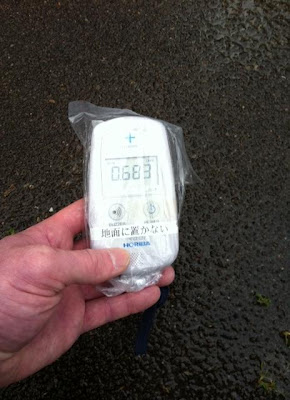Inzai City is located in the northwest corner of Chiba Prefecture, sitting in the immediate east of the high-radiation "Tokatsu" region that includes cities like Kashiwa, Nagareyama, and Abiko.
Chiba Prefecture announced on March 27, 2012 that bamboo shoots (spring delicacy in Japan) harvested in Nagareyama City and Inzai City exceeded the soon-to-be implemented new safety standard for radioactive cesium (100 Bq/kg), and requested the majors of these cities to instruct farmers to voluntarily withdraw the bamboo shoots from the market.
Again, if it's done "voluntarily", the local or national government does not need to compensate the farmers.
Nagareyama City is the one who quietly shipped the ashes from the garbage incineration plant by rail to Akita Prefecture to be buried last July. Akita Prefecture found out that the ashes contained 28,100 becquerels/kg of radioactive cesium (link is in Japanese) and they angrily returned the ashes back to Nagareyama.
From Chiba Prefecture's press release (3/27/2012; I added the English labels):
No. | 栽培地 | 採取日 | 品目 | 放射性ヨウ素131 I-131 | 放射性セシウム134 Cs-134 | 放射性セシウム137 Cs-137 | 放射性セシウム134と137の合計 Cs total |
|---|---|---|---|---|---|---|---|
| 1 | 流山市 Nagareyama | 3月26日 | たけのこ | 検出せず ND (3.9未満注) | 110 | 140 | 250 |
| 2 | 印西市 Inzai | 3月26日 | たけのこ | 検出せず (3.2未満注) | 80 | 100 | 180 |
| 3 | 旭市 Asahi | 3月26日 | たけのこ | 検出せず (2.2未満注) | 39 | 44 | 83 |
| 4 | 東庄町 Tonosho | 3月26日 | たけのこ | 検出せず (2.4未満注) | 26 | 36 | 62 |
| 5 | いすみ市 Isumi | 3月26日 | たけのこ | 検出せず (2.0未満注) | 23 | 32 | 55 |
| 6 | 君津市 Kimitsu | 3月26日 | たけのこ | 検出せず (2.2未満注) | 25 | 38 | 63 |
The last city on this table is where the controlled final disposal site is located for industrial and now radioactive waste. On March 22, a large amount of chloride ion was found in the well water at the disposal site that monitors contamination. The prefectural government thinks it is leaked from the disposal site, not because of the snow melting agent as the disposal site operator claims.
One of the readers of this blog lives in Inzai City. He has photos of how the "decontamination" is done in one elementary school in the city and "black dust" that measures close to 0.7 microsievert/hour. It looks to be a half-hearted attempt to show the residents that the city is doing something but not much effect:

The pit to bury the dirt removed by "decontamination":
Radiation level of the removed dirt: 0.224 microsievert/hour
Radiation level of the dirt that 1st graders play with: 0.268 microsievert/hour
Air radiation level near the classroom for 1st graders: 0.275 microsievert/hour
"Black dust" on the side of the paved surface:
Radiation level near the surface: 0.683 microsievert/hour
Inzai City is located here (at the blue arrow) on the radiation contour map by Professor Hayakawa of Gunma University (version 6):
(H/T Chibaguy for the photos)









 Tokyo Time
Tokyo Time
![[Most Recent Quotes from www.kitco.com]](http://www.kitconet.com/charts/metals/gold/t24_au_en_usoz_2.gif)


6 comments:
Surprise! It is all radio-fucking-active. TEPCO, the destroyer of Japan.
I don't understand the I-131 figures, is Iodine being detected in these cities?
These areas should be evacuated.
@Steve, no, I-131 is ND. The numbers are the detection limits.
Thanks, steve
Just wanted to add the device I used only measures gamma radiation and outside it is impossible to find a place under 0.2. The highest number I found was 4.7 which was confirmed by city hall. Apparently, reactor 3 is the culprit for this mess.
More plastic bag nonsense. Why does anyone in Japan think putting a plastic bag over their meter is a good plan?
Post a Comment